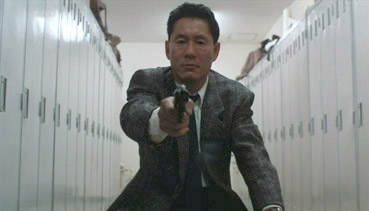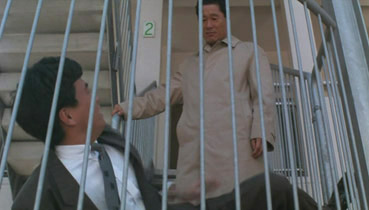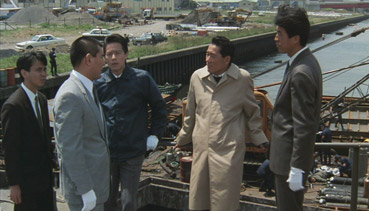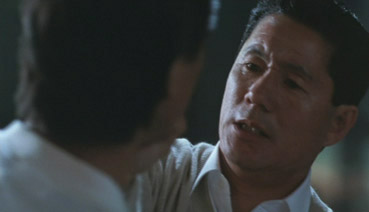|
I'm always a sucker for films that open on a facial close-up. It goes against conventional scene construction wisdom, which favours establishing location and situation before character, hence the use of term 'establishing shot' for scene-opening locational wides. But open on a facial close-up and you ask your audience to connect immediately with someone they've never met and know nothing about, then absorb the who, where and why as they go along. But it's this very break with convention that can provide a film with an instant aura of intrigue and suggest from the off that it is unlikely to play by the usual rules.
The face in question here belongs to an unnamed homeless man, a minor character whose only narrative function is to introduce us to the singular working methods of the cop of the film's international title. Two shots in, as the tramp tucks into what passes for a meal, he is set upon by three youths for no other reason than it amuses them to do so, much like Alex and his Droogs in A Clockwork Orange. Having kicked him unconscious, the three head off to their respective respectable family homes. No sooner is one of them inside than seasoned detective Azuma arrives at his bedroom door and asks to speak to him, politely requesting that his bemused mother wait downstairs while he does so. When the boy wearily responds to the repeated knocks, Azuma punches him in the face, slaps him violently across the floor and advises him and his friends to turn themselves in the following day. Unsurprisingly, they do just that, but Azuma still gets a lecture from an officious new chief, who is only too aware of the detective's reputation. "I'll say nothing," he tells him, "But behave yourself for a year, while I'm chief." Somehow you doubt this is going to happen.

There's not much ambiguity in a title like Violent Cop, but then that's not the film's actual title, but the one given to it for its international release. The original Japanese title is Sono otoko, kyōbō ni tsuki, which translates as near as a dammit as 'That man, he is dangerous', and we're talking a specific kind of dangerous for which there may be no equivalent English word. When trying to explain to me the true meaning of the kyōbō of the title, a Japanese friend pointed to amoral hit man Anton Chigurh in No Country for Old Men as a good example, which suggests the English substitution of the word 'violent' doesn't really go far enough.
Maverick cops have been a global movie favourite for many years,of course, the non-conformist individual who is prepared to tear up the rule book and plough a furrow through convention to apprehend the criminal who would otherwise escape the justice he's clearly asking for. Invariably they are a the product of the political right, the physical manifestation of a belief that a bureaucratic liberal system favours the criminal over the victim, and that the only real way to get justice is to let a lunatic loose with a big gun. That such characters have proved popular with a mass audience is not surprising, as there can be few who haven't found themselves in a situation at one time or another where their anger and frustration at the actions of others has not stirred in them a desire to deliver their own, very specific brand of justice. These characters are the embodiment of that often deeply buried desire, conscience-free rule-breakers with the officially sanctioned authority to kick ass, and the necessary ruthlessness and disregard for their own safety to make it happen. Oh if only it were that simple.
Such figures have a long history in crime fiction and an even longer one in westerns, where the maverick lawman really could be up against an almost lawless society controlled by very bad men. But it's in modern crime cinema that the character has really found an audience, one that (sometimes unconsciously) seems to share the filmmakers' despair both at changing times and revisionist cynicism at the traditional hero figure. Moral issues regarding the character's behaviour are usually (over-) simplified by making the villains unspeakably evil and having them laugh in the face of authority and those they had wronged. In 1971 this gave birth to 'Dirty' Harry Callahan, without question the most famous of all modern maverick detectives and the trendsetter for those that followed in his wake. It's surely no coincidence that the actor who played him came to international fame as an amoral western antihero.

Despite the cultural and locality shift, the shadow of Eastwood's cop can be keenly felt in Violent Cop and in the character of Azuma in particular. Both men establish early on their brutal approach to justice, both are immediately hauled up before their respective bosses and warned about their behaviour, both have a long-standing relationship with a fellow detective (in this case the almost businessman-like Iwaki), both are partnered with an eager rookie (a regular component of the Dirty Harry series), both torture their suspects to obtain information and see them walk free as a result, and both are driven to extreme action by the activities of the criminals they are pursuing.
But it's those above-mentioned cultural differences that separate Kitano's film from its American birth mother and give it it's own specific identity. Where Callahan's approach to bad guy apprehension is established with a bank robbery and "the most powerful handgun in the world," Azuma's is achieved through the brute force of physical assault, all the more shocking because it takes place in the young offender's bedroom in (presumably) full earshot of his mother. Where Callahan's contempt for authority is established through argumentative back-chat and smart remarks, Azuma shows his through silent indifference (when told the new chief wants to see him he simply nods and returns to his paper) and the motionless stares he offers as a response to the criticisms of his superiors.
A key difference between the two films is one of scale. The crimes that trigger Callahan's extreme response are headline stuff, with the character-defining armed robbery giving way to a Zodiac influenced serial killer with a particular hatred for the police and Callahan in particular. Azuma's punishment, on the other hand, is dished out to more everyday criminals, the hoodlums of the opening scene and a pimp who abuses one of his girls, a would-be hard man whose attempts to get tough with Iwaki land him a brief but brutal kicking from Azuma. Like his American counterpart, Azuma has no wife or girlfriend to soften his alpha male standing, though he is taking care of his mentally troubled sister Akari. It's a task he carries out with the same ruthlessness as his day job, dishing out an extended kicking to a young man foolish enough to take advantage of her emotional vulnerability.

Where the film comes into its own is in its handling and tone, which is striking both in how it differs from the American model and how comprehensively it defines what would become the instantly recognisable Kitano style. Certainly the film's importance in modern Japanese film history lies in its status as the ex-mansai comic and all-round media workaholic Kitano Takeshi's first feature as director, a job that he came to by chance when original director Fukusaku Kinji bowed out of the project due to scheduling conflicts. But watching the film retrospectively you can see the Kitano style already firmly established, in the use of long takes and character stillness, in the sudden and unexpected explosions of violence, in the compression of action into two static shots and a perfectly timed edit, in Kitano's own performance, in the lingering shots of the ocean. There's even a small role for Kitano's close friend Terajima Susumu, his brief appearance as a gang member giving no indication of how signature his appearances in later Kitano films would become. And although Kitano is two films away from his first teaming with regular composer Joe Hisaishi, the use of music is as wedded to the imagery as in any of his later works, with composer Kume Daisaku electronically adapting Erik Satie's Gnossienne No.1 for the main theme, and effectively counterpointing a long chase scene rather than augmenting the pace in the traditional manner.
In Azuma himself can be seen elements of a number of later Kitano tough guys, from yakuza boss Murakawa in Sonatine to the loud indignation and blather of Kikujiro's title character. A key component is Kitano's distinctive gangster walk (one he himself has rather uncharitably described as being like a duck's waddle), a confident but untidy swagger of a man who doesn't have to walk at all, but whose lumbering but purposeful momentum seems almost designed to publically announce the threat he represents, a coiled spring of potential violence kept in check by world-weariness. It's an image that was to later find it's perfect vehicle in Sonatine's Murakawa, a yakuza general who is genuinely tired of the gangster lifestyle.
The film is further distanced from its western cousins by the physical brutality of the violence. When suspects are slapped here the blows make real contact and are repeated beyond the point you'd think even the most dedicated actor would tolerate. Just occasionally this has a comic edge, as with the young man Azuma finds in his sister's bed, amusingly bumbling out flustered questions about where to catch a bus as he struggles into his clothes, only to be kicked down the stairs by the calmly unemotional Azuma, a second blow ramming his head into an iron railing in what looks like a for-real injury. The detective then escorts the hapless youngster to the bus stop, kicking him repeatedly as he questions him about his intentions towards his sister. Probably the single most violent moment owes its teeth-gritting impact as much to the filmmaking as to the action itself, as a clumsily desperate grapple between a detective and a criminal is given almost balletic grace by the music and slow motion, only to be brought to a sudden and shocking halt when a baseball bat makes contact with a head, and sound and vision are returned abruptly to normal. Such inventive handling is not isolated to this one scene – a later confrontation between Azumi and ice-cold yakuza hit man Kiyohiro involving an attempted stabbing, a head-butt and a stray bullet remains one of the most extraordinary sequences in Kitano's entire oeuvre.

Where the film does fall a little foul of convention is in Azuma's final act push towards retaliatory violence, the reasons supplied being as extreme and familiar as those in any number of Hollywood action thrillers. Compensation is provided by the aplomb with which the whole thing is staged, two genuinely startling gunshots (one shocking for the moral implications of the act), and the reaction of the newly promoted yakuza boss who delivers the final shot, contemplating the carnage before him in disbelief and muttering to himself "Everybody's crazy."
Violent Cop plays both to and against generic expectations, a cultural and artistic re-interpretation of formula that plays for the most part like a true original. Some time ago I remember seeing an interview with Quentin Tarantino, himself a major Kitano fan, in which he was attempting to explain exactly what it was that made Jean-Pierre Melville's Le Samourai such a uniquely exciting work. He identified the locale and cultural interpretation as a crucial element, suggesting that essentially what Melville had done was take elements familiar from American genre movies and transpose them to modern Paris, then adding with typical Tarantino excitement, "but that made all the difference!" Such is very much the case with Violent Cop. And how.
A pretty good but unexceptional anamorphic transfer whose punch has been stripped by the NTSC to PAL conversion, which also results in some slight blurring on fast movement, a dampening down of the colour range and a noticeable weakening of contrast when the light levels drop even a little. Things improve in sunlit exteriors, where contrast and sharpness are more pleasing.
Stereo 2.0 and surround 5.1 tracks are offered, but for the most part there's not a lot to choose between them, with almost no perceptible activity on the surrounds, though the diegetic music in the night club scene has more wallop on the 5.1 track.
The English subtitles are clear and for the most part a decent translation of the original Japanese, but a complaint I have with this and other titles in the Takeshi Kitano Collection set is that some comments, in this case small talk between the cops, are not translated. They may be little moments, but they are part of the character make-up and will remain inaccessible to those without a grounding in basic Japanese.
Audio Commentary by Chris D
The author of the book Outlaw Masters of Japanese Film growls through a commentary that blends background detail on actors with observations on the film itself, many of which should be obvious to even moderately aware viewers. It provides an OK introduction for newcomers, but Mr. D doesn't sound completely comfortable with the commentary process, and his cheerless delivery and occasionally iffy pronunciation of Japanese words make it heavy going at times.
Takeshi Kitano: The Unpredictable (68:06)
This is more like it. An episode from the acclaimed French cineaste series Cinéma, de notre temps, in which Kitano is interviewed by an unseen French presenter with translations provided by Hasumi Shigehiko, the deadpan Vice-Chancellor of Tokyo University, who also throws in a few questions of his own. It's perhaps typical of Kitano's playful approach to life that he suffers a fit of the giggles on first greeting Hasumi, but he takes the interviews themselves seriously and provides illuminating answers to a whole range of questions regarding his life, career and particularly his work as a film director. I certainly learned a few new things about him, including that he's sometimes referred to as The King on set and that this derives from his early career insistence that people call him King Idiot, and that the long walks that have become a signature element of his films were originally shot to pad out Violent Cop's too-short running time. How seriously you're meant to take him on this is open to question, of course. Scenes from several of his films are included and discussed, and we get a tantalisingly brief glimpse of the man at work, but it's the information he provides on his background and his approach to his art(s) that make this such a welcome and enthralling piece.
Kitano himself has been quoted as saying he has trouble even watching Violent Cop now, so inexperienced was he as a filmmaker, but the most striking thing about it is how assured, skillful and unflashily inventive the filmmaking is. Built on familiar foundations it may be, but it's what Kitano does with these elements that makes it such an arresting debut. Second Sight's DVD doesn't exactly sparkle on picture and sound, and I could frankly live without the commentary, but the Cinéma, de notre temps piece is a splendid inclusion that really does justify the purchase price.
|